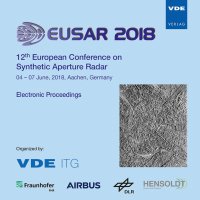Frequency Scanning applied to Wide Area SAR Imaging
Conference: EUSAR 2018 - 12th European Conference on Synthetic Aperture Radar
06/04/2018 - 06/07/2018 at Aachen, Germany
Proceedings: EUSAR 2018
Pages: 5Language: englishTyp: PDF
Personal VDE Members are entitled to a 10% discount on this title
Authors:
Roemer, Christian; Gierlich, Roland (Airbus Defence and Space GmbH, Germany)
Marquez-Martinez, Jose; Notter, Michael (Airbus Defence & Space Ltd, UK)
Abstract:
High Resolution Wide Swath Imaging (HRWS) with spaceborne SAR systems has received major attention over the recent years [1] – [3]. The favored concepts embark on multiple phase centers distributed in both azimuth and elevation direction using Digital Beamforming (DBF) techniques. Whilst the displaced phase center technique aims at improved azimuth resolution at reduced PRF the multiple phase centers in elevation aim at improved signal to noise by using the high gain pencil beam scanning on receive (SCORE) over the target area whilst illuminating the swath with a broad beam pattern on transmit. A highly interesting alternative to the SCORE based on DBF exists with a much lower hardware complexity by exploitation of an analogue frequency scanning antenna sweeping over the target area [4]. This approach offers a couple of unique features not obtainable by the SCORE technique such as inherent pulse compression, excellent signal to noise performance, inherent impulse response sidelobe suppression and overhead free data sampling at greatly reduced need of transmit peak power. There exist two different implementation options of a frequency-scanning antenna with the first relying on phase shifters permitting to set the frequency-scanning in a reconfigurable way offering more flexibility whilst requiring a higher hardware effort. The second option uses a passive frequency-scanning antenna (e.g. realized by a travelling wave antenna) requiring no phase shifters in the frontend. The proposed antenna implementation consists of a W/G travelling wave array fed from one end and with a load at the other end. Such configuration achieves beam steering in the direction of the wave propagation within the W/G by simply changing the frequency of the excitation signal, i.e. no phase taper is required for beam pointing. For SAR applications, the travelling wave arrays are arranged in elevation; producing cross-track beam steering. In this configuration and unlike conventional SAR which illuminates distinct swaths sequentially over separate time intervals, the frequency scanned beam sweeps across all swaths over each chirp. Hence, the swath width is determined by the user selected start and stop chirp frequencies. Moreover each single observed ground target is seen with the whole elevation beam (during the frequency sweep) which actually equalises the performance from near to far range avoiding the typical performance degradations appearing at the beam edges in conventional SAR. Elevation beam steering by frequency scanning can then be combined with conventional electrical phased array steering in azimuth to offer multi-mode SAR systems (e.g. Stripmap, TOPS, Spotlight, and wide-swath modes) with a reduced number of T/R elements and enhanced capabilities. A first analysis on the potential steering capabilities of the frequency-scanned SAR antennas has been conducted for a 0.7m (corresponding to the antenna height) travelling wave array at X-Band. This frequency band is particularly suitable for this technique because of the wideband reserved in the ITU allocation (recently extended to 1.2GHz) for active radars. In this case, preliminary evaluations show promising results with beam steering capabilities of up to 17deg without significant performance degradation and individual target bandwidths >150MHz (this corresponds to the 3dB antenna beam-width in the frequency domain as the beam sweeps). As an example, at an altitude of 560km, a SAR system based on this antenna could offer a potential coverage of ~300km, imaging between 33deg to 50deg incidence angles. In the paper we will explain the details of the proposed frequency scanning technique, model the antenna and corresponding SAR performance, and provide examples of affordable multi-mode SAR systems based on this technology. In addition, we will explore the capabilities of this technique to provide affordable and practical high resolution and wide swath SAR imaging.


